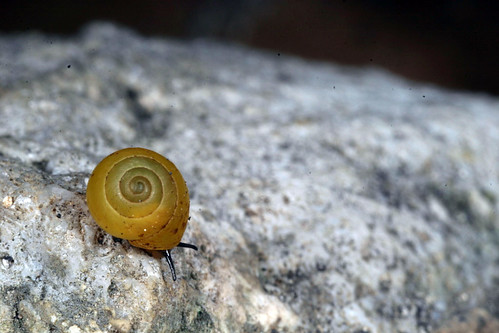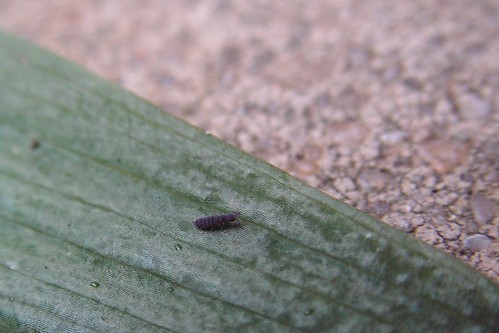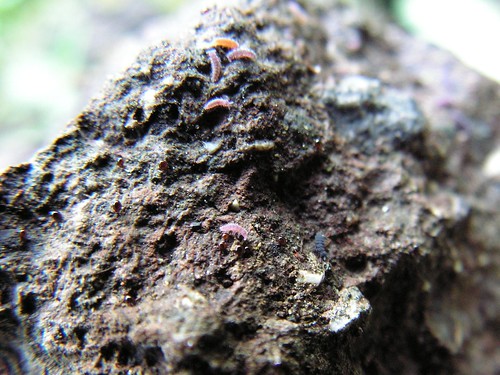Thursday, December 31, 2009
The Origin of Species and the origin of species
2009 was the double celebration for evolutionary biologists, In February we markerd the 200th anniversary of Charles Darwin's birth and in November we celberated the 150th anniversary of That Book's publication. Somehow I've managed to go the whole year without dedicating a post to Darwin's ideas about speciation. Which is odd because I've spent quite a lot of thinking about, talking about and even writing about Darwin this year. So here, with about seven hours of 2009 left are a few of my thougts on Darwin and speciation.
Darwin's book was called The Origin of Species but I'm sure that most of the tributes you've read to Darwin and his book this year will have focused on how he proved evolution had happened and provided natural selection as the mechanism required to explain modern organisms in that framework - the fact and the theory of evolution . Missing among the descriptions of the events that shaped Darwin's thinking and the thousands of strands of evidence he wove to form his thesis will have been an answer to the question the title of the books seems to ask - where do new species come from. In fact, there is a prevailing view in evolutionary biology that for all his triumphs Darwin didn't quite understand species and as a result The Origin failed to provide a theory of speciatoin. I don't think it's quite that simple.
To know what someone thinks about speciation you need to know what they think about species.
Practically, when a naturalist can unite two forms together by others having intermediate characters, he treats the one as a variety of the other, ranking the most common, but sometimes the one first described, as the species, and the other as the variety. But cases of great difficulty, which I will not here enumerate, sometimes occur in deciding whether or not to rank one form as a variety of another, even when they are closely connected by intermediate links; nor will the commonly-assumed hybrid nature of the intermediate links always remove the difficulty. The Origin, p47Darwin was the sort of person who could develop a world shattering theory, produce a body of data to support it then spent eight years looking at barnacles. Historians of science have spent a lot of ink trying to provide an explanation for "Darwin's delay". It may have been driven in part by an off-hand comment by his correspondent Hooker that only someone who has worked on the systematics of a group could hope to understand the nature of species or might just be a phenomenon all too familiar to modern systematists - a small project that grew out of control. Whatever the cause Darwin's barnacle obsession (on visiting a friend's house his son asked where his friends father "did his barnacles") clearly shaped the way he thought about species. In numerous letters of the time, especially to Hooker, he remarks on the great deal of variation he finds within barnacles of a given species and the great trouble he finds in using that variation to define the limits of species. Partly as a result of his eight years spent dissecting barnacles Darwin came to see the variation within a species as the of the same sort as the variation that exists between species and, importantly, the difference between two varieties of a given species and two distinct species as one of degree not of kind. At the risk of boiling Darwin's ideas down to the sort of diagram you might find in a powerpoint slide here's a pictorial representation.

Hence I look at individual differences, though of small interest to the systematist, as of high importance for us, as being the first step towards such slight varieties as are barely thought worth recording in works on natural history. And I look at varieties which are in any degree more distinct and permanent, as steps leading to more strongly marked and more permanent varieties; and at these latter, as leading to sub-species, and to species. The Origin, p51
It's the fact that Darwin saw no fundamental difference between varieties and species that has lead many, notably Ernst Mayr, to conclude that he didn't understand species and that The Origin was not a speciation book. I read it quite differently. To me it seems Darwin saw the term 'species' as something a systematist could apply to a group of organisms sometime after a process he called divergence (which we would now call speciation) has started to form discontinuities between them.
The big question then is what is the process that drives the discontinuities that make for species? The clearest answer to question comes in Chapter 4 of The Origin. Here is one example of Darwin's ideas about the principle of divergence.
It has been experimentally proved, that if a plot of ground be sown with one species of grass, and a similar plot be sown with several distinct genera of grasses, a greater number of plants and a greater weight of dry herbage can be raised in the latter than in the former case. The same has been found to hold good when one variety and several mixed varieties of wheat have been sown on equal spaces of ground. Hence, if any one species of grass were to go on varying, and the varieties were continually selected which differed from each other in the same manner, though in a very slight degree, as do the distinct species and genera of grasses, a greater number of individual plants of this species, including its modified descendants, would succeed in living on the same piece of ground. And we know that each species and each variety of grass is annually sowing almost countless seeds; and is thus striving, as it may be said, to the utmost to increase in number. Consequently, in the course of many thousand generations, the most distinct varieties of any one species of grass would have the best chance of succeeding and of increasing in numbers, and thus of supplanting the less distinct varieties; and varieties, when rendered very distinct from each other, take the rank of species. The Origin, p88In typically prescient fashion Darwin took a proto-ecological view to the experimental evidence that plots sown with multiple plant species where more productive than monocultures. If the the mixed-species plot is doing better than the monoculture it must mean each species is taken advantage of different resources in that plot - what we'd now call distinct ecological niches. But then he took it yet further. What would happen if we let that monoculutre grow on for several generations. We know from his barnacles and from all the examples he listed in the previous chapters of The Origin that variants will arise. A very few of those variants will be able to make use of some of the resources that were previously going untapped. Over many generations natural selection would act - the most specialised forms would produce more seeds and produce more variants while forms intermediate between the ancestral species, not being masters of either niche, would be out competed and driven to extinction. Let this process continue long enough and you'd get first new varietes and finally, since they are just very distinct varietes, new species. Darwin provides his own diagram (the only one in the book) to describe this process and its phylogenetic implications but that is, in my supervisor's words, "a rattly looking thing" so here's one from me.

I find it very hard to marry the received wisdom that Darwin failed to understand the nature of species and provided on theory of speciation with the arguments Darwin presented in The Origin. When his species concept is viewed (as I think all such concepts should be) as a diagnostic tool rather than an essential definition then his is as good as any other. His theory of speciation as presented doesn't hold up to our modern knowledge of genetics but the underlying process, selection driving ecological specialisation, forms one half of our modern models of speciation that don't involve geographical isolation and those that involve secondary contact between incipient species.
Labels: Darwin, evolution, history of science, might interest someone, sci-blogs, science, speciation
Sunday, December 13, 2009
Sunday Spinelessness - a snail!
So far, every single post in the Sunday Spinelessness series has been an arthropod. That's not surprising in terms of numbers - by any sensible metric arthropods are the most successful animals on earth. They include about 90% of described species and only nematodes could get close to springtails and ticks in terms of numbers of individuals. Still, it's a shame to use a series of posts aimed at highlighting some of the overlooked creatures around us and just ignore 35 phyla each as different from each other as arthropods are from us chordates. Especially if you study landsnails for a living!
Allow me to introduce you to Orobophana pacifica
O. pacifica is one of the snails I collected in my field trip to the Cook Islands as a bit of a back up plan - if the species I focused on turned out to be dull then I could fall back on studying these guys. In fact, the species I've focussed on have turned out to be, in my own estimation, pretty exciting so I haven't spent any time trying to understand O. pacfica which is a pity because they're pretty cool snails. They are tiny (the shell is around 5mm diameter) and live on coral rubble mainly around the coast on each of the Southern islands in the Cook Islands. Even though they live on land they aren't closely related to the "true" landsnails in the order Stylommatophora. To see the difference you need to look into their eyes. If you click on the image above to get a high resolution version you might just be able to see the eye - it's a black dot just underneath the tentacles ("feelers"). In true landsnails like the ones you find in you garden the eyes sit on the ommatophores, a second set of tentacles which are retractable. Orobophana sits inside a family of snails called the Helicinidae which represent an invasion of the land by snails distinct from that which gave us the "true" landsnails.
O. pacifica plays an important part in Cook Island's culture especially in the southern most island Mangaia. The Māori name for the snail is pūpū and locals have traditionally laced the shells together to make necklaces called 'ei pūpū - you can see some examples in Te Papa's online collections. In Mangaia at least the tradition is kept up - the process of making 'ei pūpū is taught at school and you can buy Mangaian necklaces in Rarotonga (though they are often sold alongside much cheaper Chinese manufactured necklaces). Peter Buck recorded six different names for types of pūpū in his Material Culture of the Cook Islands - it's likely one of those names represents a distinct Helicinid species while the others may represent rare varieties of shell within O. pacifica.
Labels: Cook Islands, Helicinidae, sci-blogs, snails, sunday spinelessness
Peer Review for the Climate "Science" Coalition
A couple of weeks ago it got a bit more serious. The New Zealand Climate "Science" Coalition (C"S"C) put out a press release [PDF] that accused NIWA of scientific fraud. If you missed the story my sciblings Gareth and Ken have covered it in detail. The short version is the C"S"C collated temperature records for each of the regions that contributed to NIWA's national long term climate data series and found no significant trend in the raw data despite the fact NIWA's series has New Zealand warming by almost a degree in the last century. So, presumably in an attempt to put a local angle on the "climategate" story they released that extraordinary press release. I reproduce some of the highlights below.
... the station histories are unremarkable. There are no reasons for any large corrections. But we were astonished to find that strong adjustments have indeed been made.
The shocking truth is that the oldest readings have been cranked way down and later readings artificially lifted to give a false impression of warming, as documented below. There is nothing in the station histories to warrant these adjustments and to date Dr Salinger and NIWA have not revealed why they did this.
We have discovered that the warming in New Zealand over the past 156 years was indeed man-made, but it had nothing to do with emissions of CO2 it was created by man-made adjustments of the temperature. It's a disgrace.
New Zealand's contribution to the global statistics is now under a shadow, so there could be regional or even global implications of these disgraceful adjustments which should be investigated.
Now we must ask: do we really need an ETS? For, if all that nasty carbon dioxide and methane we are pumping into the atmosphere has utterly failed to increase our temperature until now, why ever should it do so in the future?
Got that? There has been no warming in New Zealand, NIWA scientists purposefully changed the data to fit their agenda, this is a disgrace (and indeed shocking, disgraceful and astonishing) now that we know that there has been no warming in New Zealand we can dump the ETS. Since that release they've walked their claims back somewhat, in that annoying "oh, we were just putting it out there" way people that say outrageous things usually fall back to but it was the claims in their press release that started the story. The basis of all those fervid claims, that the adjustments made to the NIWA data were arbitrary, can only be described as a lie. Since the C"S"C stitched together the data for each region from multiple stations they knew very well that the some of NIWA's adjustments were made to take into account the change in recording station used to take the region's temperature. Moreover, as Ken has pointed out, if the C"S"C really wanted earn the "S" in their name they could have looked at the "flat" data they were presenting to see if stitching together data from those different stations without accounting for the change was more or less "shocking" then NIWA's adjustments.
Since the Wellington series has the simplest station history let's use that as an example. Before 1927 Wellington's temperature was recorded at Thorndon, just above sea level. In 1928 the station was moved to Kelburn about 120m above sea level. It will be news to no-one that as you get higher is gets cooler and, in fact, the C"S"C found a cooling trend in the Wellington of 0.7° per century. But even without knowing about the alititude of each station we can test for an effect of the station move in the raw data. Statistical tests have a horrible way of boiling down to a series of p-values - when you run tests on the raw data it turns out that the change of station has a significant effect on the temperature recorded but what does that mean? Perhaps the easiest way to understand just how wrong it would be to draw conclusions from the raw data without including a station effect is to compare how well each of a set of different models explain the raw data.
The C"S"C's -0.7°C trend comes from a simple model - a single linear trend over the length of observation. You could also imagine a model, lets call it the "altitude effect" model , in which a single linear trend applies over the length of observation but temperatures at the Kelburn station are offset by some factor (also estimated as a best fit) as a result of that stations elevation. You might even imagine another model "two slopes" in which as well as being offset by some factor temperatures at Kelburn were following a different trend than those down at sea level. I ran those regressions and got a bunch of numbers:
| Comparing our models | ||||
|---|---|---|---|---|
| Model | Rate (95% CI) | Variance explained | AIC | |
| C"S"C | -0.21 (-0.43 — -0.02) | 3% | 213.18 | |
| Altitude Effect | 0.72 (0.37 — 1.07) | 25% | 179.82 | |
| Two Slopes | Before move | 0.11 (-0.50 — 0.72) | ||
| After move | 1.01 (0.27 — 1.75) | 28% | 175.80 |
And indeed some pretty graphs:

The first thing that you note when you look at the table above is I didn't reproduce that -0.7°C trend even after going to *shudder* excel to check - I'm sure there is nothing untoward but going on but it is strange. For our purposes the values in "variance explained" and "AIC" are more important. The first of those is fairly self explanatory - how much of the total variance in the dataset is explained by the given model, AIC is a measure of how well the model fits scaled for the number of parameters used in the model ( which is a good thing to check because you can almost always explain some of the variance in dataset by adding another variable whether its meaningful or not) lower numbers represent a better fit. Between the table and the graphs we can see what it means when I say the station move has a significant effect on the temperature recorded - not including it in our estimate of the trend ignores a major source of variation in the data. When the move is incorporated we estimate a trend of 0.72°C per century ( and we can be 95% sure that value falls between 0.37°C — 1.07°C ) over the length of observation. Interestingly our third model is actually the best of the bunch. This is likely an artefact of trying to put a straight line through a trend that really isn't linear. Warming in the second half of the 20th Century was about twice as fast as earlier warming, since only the Kelburn observations include this accelerated warning fitting a line through that section separately fits the data better (though the uncertainty in our estimate of the trend is much larger since their are less data points making it up)
In reply to comments from Ken the C"S"C, who had called their press release a "research paper", claimed that a process equivalent to peer review would not have invalidated any of scientific claims that they made. In fact, even a very simple look at their data have shown that drawing conclusions of the sort the C"S"C did from the raw data would be terrible science and accusing NIWA scientists of fraud on that basis really is disgraceful.Labels: climate change, environment and ecology, sci-blogs, stats
Sunday, December 6, 2009
Sunday Spinelessness - collembola 2.0
The subject of this week's Sunday Spinelessness is one of the most important organisms in the world:
Labels: collembola, environment and ecology, mites, photos, sci-blogs, sunday spinelessness





